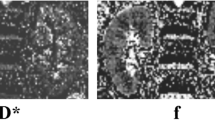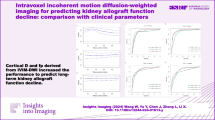Abstract
Objective
To compare the value of reduced field-of-view (FOV) intravoxel incoherent motion (IVIM) diffusion-weighted imaging (DWI) and arterial spin labeling (ASL) for assessing renal allograft fibrosis and predicting long-term dysfunction.
Methods
This prospective study included 175 renal transplant recipients undergoing reduced FOV IVIM DWI, ASL, and biopsies. Renal allograft fibrosis was categorized into ci0, ci1, ci2, and ci3 fibrosis according to biopsy results. A total of 83 participants followed for a median of 39 (IQR, 21–42) months were dichotomized into stable and impaired allograft function groups based on follow-up estimated glomerular filtration rate. Total apparent diffusion coefficient (ADCT), pure diffusion ADC, pseudo-perfusion ADC, perfusion fraction f from IVIM DWI, and renal blood flow (RBF) from ASL were calculated and compared. The area under the receiver operating characteristic curve (AUC) was calculated to assess the diagnostic and predictive performances.
Results
RBF was different in ci0 vs ci1 (147.9 ± 46.3 vs 126.0 ± 49.4 ml/min/100 g, p = .02) and ci2 vs ci3 (92.9 ± 46.9 vs 70.8 ± 37.8 ml/min/100 g, p = .03). RBF in the stable group was higher than that in the impaired group (144.73 ± 49.33 vs 102.19 ± 47.58 ml/min/100 g, p < .001). AUCs in distinguishing renal allograft fibrosis and predicting long-term allograft dysfunction for RBF were higher than cortical ADCT (ci0 vs ci1–3, 0.76 vs 0.59, p < .001; ci0–1 vs ci2–3, 0.79 vs 0.68, p = .01; ci0–2 vs ci3, 0.79 vs 0.68, p = .01; 0.76 vs 0.60, p = .04, respectively).
Conclusion
Compared to reduced FOV IVIM DWI, ASL was a more promising technique for noninvasively distinguishing renal allograft fibrosis degree and predicting long-term allograft dysfunction.
Key Points
• Compared to total ADC from rFOV IVIM DWI, RBF from ASL can distinguish no fibrosis (ci0) vs mild fibrosis (ci1) (p = .02) and moderate fibrosis (ci2) vs severe fibrosis (ci3) (p = .04).
• RBF had superior performance than diffusion parameters in discriminating fibrosis (no fibrosis [ci0] vs fibrosis [ci1–3], mild fibrosis [ci0–1] vs moderate to severe fibrosis [ci2–3], non-severe [ci0–2] vs severe [ci3] fibrosis; AUC = 0.76 vs 0.59, p < .001; 0.79 vs 0.68, p = .01; 0.79 vs 0.68, p = .01).
• Compared to reduced FOV IVIM DWI, ASL was a more promising technique for noninvasively predicting long-term allograft dysfunction (AUC = 0.76 vs 0.60, p = .04).






Similar content being viewed by others
Abbreviations
- ADC:
-
Apparent diffusion coefficient
- ASL:
-
Arterial spin labeling
- AUC:
-
Area under the receiver operating characteristic curve
- DWI:
-
Diffusion-weighted imaging
- eGFR:
-
Estimated glomerular filtration rate
- FOV:
-
Field of view
- ICC:
-
Intraclass correlation coefficient
- IVIM:
-
Intravoxel incoherent motion
- RBF:
-
Renal blood flow
References
Lovisa S, LeBleu VS, Tampe B et al (2015) Epithelial-to-mesenchymal transition induces cell cycle arrest and parenchymal damage in renal fibrosis. Nat Med 21(9):998–1009
Li X, Zhuang S (2014) Recent advances in renal interstitial fibrosis and tubular atrophy after kidney transplantation. Fibrogenesis Tissue Repair 7:15
Azancot MA, Moreso F, Salcedo M et al (2014) The reproducibility and predictive value on outcome of renal biopsies from expanded criteria donors. Kidney Int 85(5):1161–1168
Baues M, Dasgupta A, Ehling J et al (2017) Fibrosis imaging: current concepts and future directions. Adv Drug Deliv Rev 121:9–26
Jiang K, Ferguson CM, Lerman LO (2019) Noninvasive assessment of renal fibrosis by magnetic resonance imaging and ultrasound techniques. Transl Res 209:105–120
Buchanan CE, Mahmoud H, Cox EF et al (2020) Quantitative assessment of renal structural and functional changes in chronic kidney disease using multi-parametric magnetic resonance imaging. Nephrol Dial Transplant 35(6):955–964
Morrell GR, Zhang JL, Lee VS (2017) Magnetic resonance imaging of the fibrotic kidney. J Am Soc Nephrol 28(9):2564–2570
Li J, An C, Kang L, Mitch WE, Wang Y (2017) Recent advances in magnetic resonance imaging assessment of renal fibrosis. Adv Chronic Kidney Dis 24(3):150–153
Eisenberger U, Binser T, Thoeny HC, Chris B, Felix JF, Peter V (2014) Living renal allograft transplantation: diffusion-weighted MR imaging in longitudinal follow-up of the donated and the remaining kidney. Radiology 270(3):800–808
Eisenberger U, Thoeny HC, Binser T et al (2010) Evaluation of renal allograft function early after transplantation with diffusion-weighted MR imaging. Eur Radiol 20(6):1374–1383
Yu Y, Ni Q, Wang Z, Chen M, Zhang L (2019) Multiparametric functional magnetic resonance imaging for evaluating renal allograft injury. Korean J Radiol 20(6):894–908
Xie Y, Li Y, Wen J et al (2019) Functional evaluation of transplanted kidneys with reduced field-of-view diffusion-weighted imaging at 3T. Korean J Radiol 19(2):201–208
Artz NS, Sadowski EA, Wentland AL et al (2011) Reproducibility of renal perfusion MR imaging in native and transplanted kidneys using non-contrast arterial spin labeling. J Magn Reson Imaging 33(6):1414–1421
Cai YZ, Li ZC, Zuo PL et al (2017) Diagnostic value of renal perfusion in patients with chronic kidney disease using 3D arterial spin labeling. J Magn Reson Imaging 46(2):589–594
Ren T, Wen CL, Chen LH et al (2016) Evaluation of renal allografts function early after transplantation using intravoxel incoherent motion and arterial spin labeling MRI. Magn Reson Imaging 34(7):908–914
Selby NM, Blankestijn PJ, Boor P et al (2018) Magnetic resonance imaging biomarkers for chronic kidney disease: a position paper from the European the Cooperation in Science and Technology Action PARENCHIMA. Nephrol Dial Transplant 33(Suppl_2):ii4–ii14
Mendichovszky I, Pullens P, Dekkers I et al (2020) Technical recommendations for clinical translation of renal MRI: a consensus project of the Cooperation in Science and Technology Action PARENCHIMA. MAGMA 33(1):131–140
Wang W, Yu Y, Wen J et al (2019) Combination of functional magnetic resonance imaging and histopathologic analysis to evaluate interstitial fibrosis in kidney allografts. Clin J Am Soc Nephrol 14(9):1372–1380
Prasad PV, Li LP, Thacker JM et al (2019) Cortical perfusion and tubular function as evaluated by magnetic resonance imaging correlates with annual loss in renal function in moderate chronic kidney disease. Am J Nephrol 49(2):114–124
Srivastava A, Cai X, Lee J et al (2020) Kidney functional magnetic resonance imaging and change in eGFR in individuals with CKD. Clin J Am Soc Nephrol 15(6):776–783
Pfefferbaum A, Chanraud S, Pitel AL et al (2011) Cerebral blood flow in posterior cortical nodes of the default mode network decreases with task engagement but remains higher than in most brain regions. Cereb Cortex 21(1):233–244
Loupy A, Haas M, Solez K et al (2017) The Banff 2015 kidney meeting report: current challenges in rejection classification and prospects for adopting molecular pathology. Am J Transplant 17(1):28–41
Levey AS, Stevens LA, Schmid CH et al (2009) A new equation to estimate glomerular filtration rate. Ann Intern Med 150(9):604–612
Kasiske BL, Israni AK, Snyder JJ, Skeans MA (2011) The relationship between kidney function and long-term graft survival after kidney transplant. Am J Kidney Dis 57(3):466–475
Bane O, Hectors SJ, Gordic S et al (2020) Multiparametric magnetic resonance imaging shows promising results to assess renal transplant dysfunction with fibrosis. Kidney Int 97(2):414–420
DeLong ER, DeLong DM, Clarke-Pearson DL (1988) Comparing the areas under two or more correlated receiver operating characteristic curves: a nonparametric approach. Biometrics 44(3):837–845
Xu X, Palmer SL, Lin X et al (2018) Diffusion-weighted imaging and pathology of chronic kidney disease: initial study. Abdom Radiol (NY) 43(7):1749–1755
Woo S, Cho JY, Kim SY (2018) Intravoxel incoherent motion MRI-derived parameters and T2* relaxation time for noninvasive assessment of renal fibrosis: an experimental study in a rabbit model of unilateral ureter obstruction. Magn Reson Imaging 51:104–112
Inoue T, Kozawa E, Okada H et al (2011) Noninvasive evaluation of kidney hypoxia and fibrosis using magnetic resonance imaging. J Am Soc Nephrol 22(8):1429–1434
Zhao J, Wang ZJ, Liu M et al (2014) Assessment of renal fibrosis in chronic kidney disease using diffusion-weighted MRI. Clin Radiol 69(11):1117–1122
Mao W, Zhou J, Zeng M et al (2018) Intravoxel incoherent motion diffusion-weighted imaging for the assessment of renal fibrosis of chronic kidney disease: a preliminary study. Magn Reson Imaging 47:118–124
Cai X, Yu J, Zhou Q, Du B, Feng Y, Liu X (2016) Use of intravoxel incoherent motion MRI to assess renal fibrosis in a rat model of unilateral ureteral obstruction. J Magn Reson Imaging 4(3):698–706
Ix JH, Katz R, Bansal N et al (2017) Urine fibrosis markers and risk of allograft failure in kidney transplant recipients: a case-cohort ancillary study of the FAVORIT trial. Am J Kidney Dis 69(3):410–419
Oberbauer R (2016) Progression of interstitial fibrosis in kidney transplantation. Clin J Am Soc Nephrol 11(12):2110–2112
Torres IB, Moreso F, Sarró E, Meseguer A, Serón D (2014) The interplay between inflammation and fibrosis in kidney transplantation. Biomed Res Int 2014:750602
Heilman RL, Smith ML, Smith BH et al (2016) Progression of interstitial fibrosis during the first year after deceased donor kidney transplantation among patients with and without delayed graft function. Clin J Am Soc Nephrol 11(12):2225–2232
Acknowledgements
We thank Dr. Mingchao Zhang of the National Clinical Research Center of Kidney Diseases, Nanjing University School of Medicine, Nanjing, China, for his help with analysis of the biopsy specimens.
Funding
The authors state that this work has not received any funding.
Author information
Authors and Affiliations
Corresponding author
Ethics declarations
Guarantor
The scientific guarantor of this publication is Long Jiang Zhang.
Conflict of interest
The authors of this manuscript declare no relationships with commercial companies.
Statistics and biometry
No complex statistical methods were necessary for this paper.
Informed consent
Written informed consent was obtained from all participating patients.
Ethical approval
Institutional Review Board approval was obtained.
Methodology
• prospective
• diagnostic study/observational
• performed at one institution
Additional information
Publisher’s note
Springer Nature remains neutral with regard to jurisdictional claims in published maps and institutional affiliations.
Supplementary Information
ESM 1
(DOCX 347 kb)
Rights and permissions
About this article
Cite this article
Yu, Y.M., Wang, W., Wen, J. et al. Detection of renal allograft fibrosis with MRI: arterial spin labeling outperforms reduced field-of-view IVIM. Eur Radiol 31, 6696–6707 (2021). https://doi.org/10.1007/s00330-021-07818-9
Received:
Revised:
Accepted:
Published:
Issue Date:
DOI: https://doi.org/10.1007/s00330-021-07818-9




